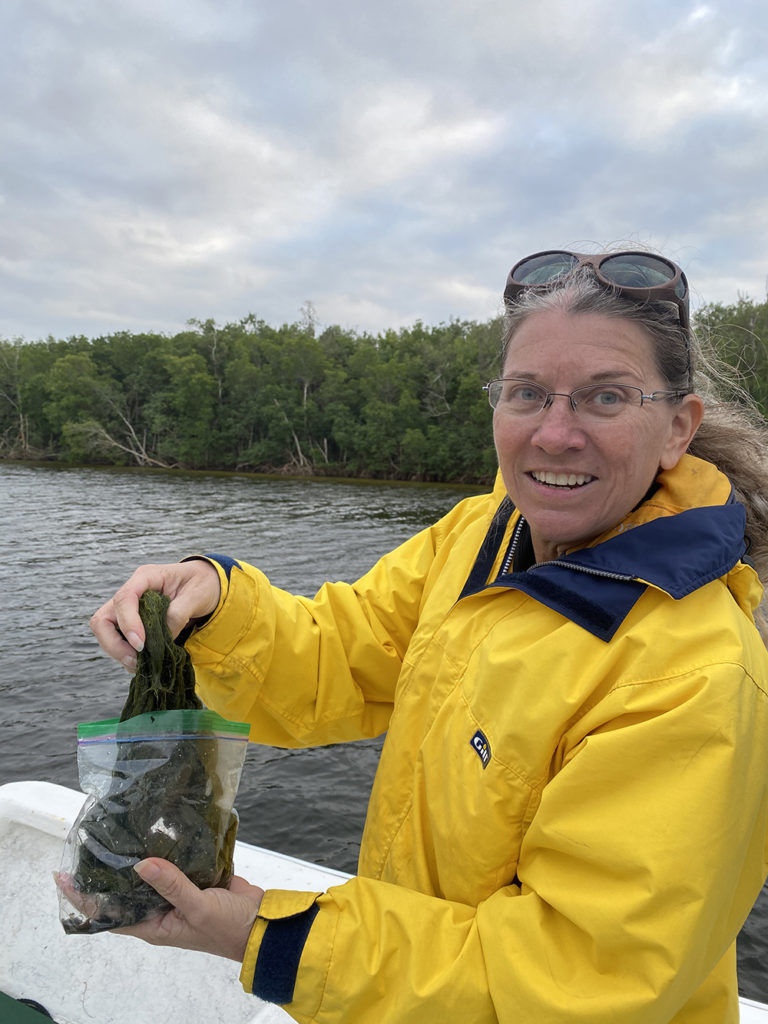Staugler gathering a macroalgae pattern from Charlotte Harbor, Florida. Picture courtesy of UF/IFAS.
In celebration of Ladies’s Historical past Month, Florida Sea Grant proudly highlights Betty Staugler, a person whose dedication to marine conservation has not solely outlined her profession but additionally earned her a singular and sudden honor – the dignity of getting a newly found cyanobacteria named after her.
Sirenicapillaria stauglerae, which stems from the Greek and Latin derivation of “mermaid’s hair”, could seem to be a whimsical title choice for algae. Though some speculate that the algae’s title could also be impressed by the wavy, lengthy locks of Florida Sea Grant’s Elizabeth “Betty” Staugler, it primarily stands as a tribute to Staugler’s steadfast dedication to learning and surveying coastal marine habitats, and her essential involvement within the algae’s discovery.
Betty Staugler at present serves because the NOAA Dangerous Algal Bloom (HAB) liaison, a Sea Grant/Federal company initiative funded by the Nationwide Sea Grant Workplace and federal companions from NOAA, and hosted by Florida Sea Grant. This system consists of monitoring dangerous algal blooms utilizing satellite tv for pc knowledge and creating short-term and long-term forecasts carried out by NOAA Nationwide Facilities for Coastal Ocean Science (NCCOS) the place she works to acquire stakeholder enter on wants and supply codecs.
Staugler works with the NOAA Coast Watch crew to develop on-line video tutorials addressing satellite tv for pc entry, utilization, downloading, mission integration, and limitations. Her position additionally includes outreach and schooling within the nationwide Sea Grant community. She collaborates with states, conducts workshops, and coordinates “HAB chats” to encourage communication and collaboration throughout the Sea Grant applications.
Earlier than moving into her present position, Staugler spent a powerful 17 years as a Florida Sea Grant UF/IFAS extension agent in Charlotte County. Throughout this tenure, she spearheaded the creation of the Eyes on Seagrass program, a citizen science initiative centered round seagrass monitoring. She engaged with various group members, to conduct surveys of macroalgae lurking in seagrass beds—a matter that resonated strongly among the many native fishing guides and anglers.
One such encounter was with Captain Van Hubbard in 2020, a fishing information in Englewood. Involved in regards to the severity of the seagrass and macroalgae in his space, Staugler met Captain Hubbard and ventured out onto the water to gather macroalgae samples. The samples had been forwarded to Dr. Dail Laughinghouse, an Affiliate Professor of Utilized Phycology and a UF analysis affiliate of Florida Sea Grant, for identification. Dr. Laughinghouse and his crew’s collaboration resulted within the discovery of recent species of algae inside a singular genus.
Photos of Sirenicapillaria pattern. Determine 16 reveals hair-like thalli, or plant physique of the algae. Picture courtesy of David E. Berthold.
The naming of Stauglerae is immediately impressed by Betty Staugler’s discovery efforts. In distinction, Sirenicapillaria, stemming from the Greek phrase “Siren” (Greek Σειρήν) and the Latin phrase “capillus,” which means hair, refers back to the ‘mermaid’s hair’ look of those marine cyanobacteria.
“The kind of algae named after me is characterised by its skinny and darkish brown algae composition. The skinny strands of this algae seem like hairs that cling down within the water,” says Staugler.
Simply because the sound of sirens indicators impending hazard, sightings of Sirenicapillaria point out a potential risk.
In 2022, Dr. Laughinghouse and his crew revealed a analysis manuscript that identifies a number of varieties of those cyanobacteria together with Sirenicapillaria stauglerae. Of their scientific manuscript, Dr. Laughinghouse and his crew observe that Sirenicapillaria thrives alongside the western Florida Coast and kinds floating mats within the Florida Keys. These cyanobacteria trigger vital injury to seagrass beds annually, significantly in the course of the spring and summer time months, imposing substantial constraints on native economies and detrimental results on marine life.
“These algae develop on the seafloor, typically attaching themselves to seagrass. As they develop, they create oxygen bubbles. Over time, these bubbles can elevate the algae off the seafloor, floating to the floor and decomposing, emitting a robust odor. The decomposition includes micro organism, resulting in a hydrogen sulfide odor, triggering citizen complaints, and posing well being issues, ” says Staugler.
Whereas the understanding of this new algal discovery is proscribed, Betty Staugler emphasizes the importance of present analysis in uncovering potential threats and informing conservation methods – all of which might not have been attainable with out her. Acknowledging Staugler’s pivotal position in facilitating this groundbreaking analysis, the scientific group paid tribute by naming one of many newfound algae species after her.
“It’s such an unlikelable algae,” jokes Staugler. “However from a scientific perspective, it’s the head of my profession to have one thing named after me.” She acknowledges the important position of cyanobacteria, stating, “We owe our life to cyanobacteria, with out them, there could be no us. They had been the primary issues to photosynthesize.”
When discussing the potential and challenges for monitoring and forecasting dangerous algal blooms, together with Sirenicapillaria stauglerae, Staugler expresses an optimistic view.
“Water sampling precisely identifies the kind of algae, and satellite tv for pc imaging exposes the extent of a bloom, enhancing our sampling methods and offering superior warnings of potential impacts,” Staugler emphasizes. “Acknowledging the need for increased decision imagery, new satellites are coming on-line, and the NOAA crew is actively creating new algorithms to fulfill this requirement.”
